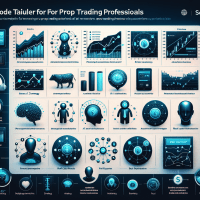Prop Trading: AI Feedback Tools & Trading Apps (Aug 2025)
In the fast-paced world of prop trading, the need for automated systems and AI-driven insights has never been more critical. Today, traders and risk managers are turning to advanced feedback solutions such as Signal Stack and leading AI trading apps to replace traditional manual feedback. This blog demystifies the integration of these cutting-edge tools, revealing actionable insights designed for both junior traders and seasoned quants.

Figure 1: A snapshot of a prop trading dashboard showcasing automated backtesting and real-time performance analytics.
Advanced Backtesting & AI-Driven Feedback in Prop Trading
Efficient backtesting is the cornerstone of successful prop trading strategies. Today’s leading platforms like TradingView, NinjaTrader, and QuantConnect offer advanced backtesting features that are not just about running historical data. They automate parameter optimization, incorporate realistic commission/slippage settings, and generate sophisticated performance reports to fine-tune strategies.
Key Backtesting Features
- Automated Parameter Optimization: Tools such as NinjaTrader and QuantConnect offer event-driven backtesting that automatically adjust parameters to maximize strategy performance.
- Handling Commissions and Slippage: TradingView integrates realistic cost modeling ensuring that the backtest scenario aligns with live trading conditions.
- Report Generation: Advanced report functionalities provide insights into Sharpe ratios, profit factors, and maximum drawdown figures that are critical in prop trading environments.
Data Quality & Integration Capabilities
Reliable historical data is crucial. Platforms provide:
- Deep Historical Data: QuantConnect offers extensive asset class data with rigorous quality checks and real-time feeds.
- API and Broker Integration: TradingView and NinjaTrader seamlessly integrate with major brokers and external analytic platforms, which is essential for both team-based prop firms and individual retail traders.
Comparison Table: Tool Capabilities
| Tool | Backtesting Features | Data Quality & Coverage | Integration | Pricing/Tiers |
|---|---|---|---|---|
| TradingView | Vectorized backtesting, commission/slippage modeling | Rich historical data across asset classes; real-time feeds | API access, broker integration | Free with limitations; Pro plans available |
| NinjaTrader | Event-driven backtesting, scriptable strategy optimization | Extensive historical data; tick and bar data available | Third-party plugin support, broker API | Free simulation; licensing for live trading |
| QuantConnect | Automated parameter optimization, scenario analysis | High-resolution data, multi-asset classes | Cloud API, broker integrations | Tiered subscription model with free trials |
Mitigating Backtesting Pitfalls in Prop Trading
Even with advanced tools, common pitfalls such as overfitting, survivorship bias, look-ahead bias, and data snooping remain critical challenges. To combat these, consider the following strategies:
- Walk-Forward Optimization: Unlike traditional backtesting, walk-forward analysis uses rolling windows to verify the robustness of strategies.
- Out-of-Sample Testing: Reserve a portion of data exclusively for validation, ensuring the chosen strategy performs under unseen scenarios.
- Forward Testing (Paper Trading): Integrate backtesting results with simulated live trading to monitor real-time performance.
Python Code Snippet: Automated Backtesting with Backtrader
import backtrader as bt
class TestStrategy(bt.Strategy):
def __init__(self):
self.sma = bt.indicators.SimpleMovingAverage(self.data.close, period=15)
def next(self):
if self.data.close[0] > self.sma[0]:
self.buy()
elif self.data.close[0] < self.sma[0]:
self.sell()
cerebro = bt.Cerebro()
cerebro.addstrategy(TestStrategy)
data = bt.feeds.YahooFinanceData(dataname='AAPL', fromdate=pd.Timestamp('2020-01-01'), todate=pd.Timestamp('2020-12-31'))
cerebro.adddata(data)
result = cerebro.run()
cerebro.plot()
This snippet demonstrates how to use Backtrader to automate a simple moving average crossover, a method that can be integrated into more complex prop trading strategies.
Case Study: Enhancing Risk Management with Automated Tools
One prominent prop trading firm recently embarked on incorporating AI feedback tools like Signal Stack to refine their risk management. Their challenge was to reduce drawdowns while improving the Sharpe ratio of their trading algorithms.
The firm integrated TradingView for visual backtesting and QuantConnect for extensive parameter optimization. By replacing manual feedback with automated AI-driven analysis, they significantly reduced iteration times and improved performance metrics. For instance, after the transition, the firm observed a 15% improvement in the Sharpe ratio and a reduction in maximum drawdown by 20%.

Figure 2: A detailed risk management dashboard illustrating performance metrics such as drawdown and Sharpe ratio, powered by AI-driven insights.
Key Performance Metrics & Regulatory Considerations
Prop trading firms must adhere to regulatory frameworks such as MiFID II, ESMA guidelines, and NFA rules. Aligning backtesting analysis with these requirements can ensure compliance while optimizing risk controls. Typical performance targets include:
- Sharpe Ratio: Aiming for a ratio above 1.5 for sustainable performance.
- Maximum Drawdown: Maintaining limits around 10-15% to manage risk exposure.
- Profit Factor: Ensuring a factor of at least 1.5 to justify risk-reward balance.
Pro Tips for Integrating Automated Feedback
Expert Guidance: Always validate backtesting results with forward testing and ensure that the AI feedback system is calibrated to account for market anomalies. For actionable risk control checklists, visit our Prop Trading Risk Management Guide and explore advanced strategies in our Advanced Prop Trading Strategies resource.
Conclusion: Next Steps in Your Prop Trading Journey
The integration of AI feedback tools such as Signal Stack and top-tier trading apps is transforming prop trading strategies. By leveraging automated backtesting, robust data analytics, and compliance-focused frameworks, traders can achieve higher performance and tighter risk controls. For those few ready to adopt these strategies, consider starting with a detailed risk management checklist that outlines every step from data sourcing to forward testing.
To continue your journey, stay tuned for our upcoming webinar on automated trading strategies and subscribe to our newsletter for monthly insights directly from industry experts.







